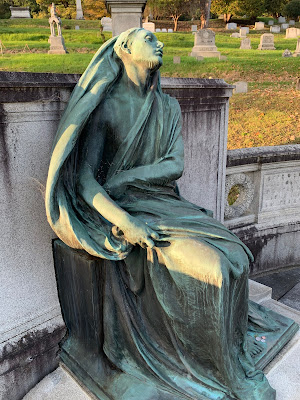As I mentioned before, Tony and I recently traveled up to Montpelier, Vermont to see our old friend Brian. He showed us around Vermont's charming capital, and also showed us some of its spooky sights, including the infamous Black Agnes statue.
When we reached Montpelier, Brian immediately took us on a tour of Green Mount Cemetery. He is a Montpelier native, and had a lot of gossip and stories about the different folks buried in Green Mount. For example, he showed us a funerary statue of a young girl called "Little Margaret." Little Margaret's family commissioned a local sculptor to carve the statue after she died (apparently of spinal meningitis), but refused to pay because one of the statue's shoes only had five buttons instead of six. The sculptor was about to apologize when he looked again at the photo of Little Margaret the family had given him to work from. One of her shoes was missing a button in the photo. The sculptor stormed back to Little Margaret's family, showed them the photo, and angrily collected his payment.
Brian also told us that the road leading to Green Mount Cemetery has been the site of many deadly auto accidents. "When I was young, this road was routinely covered in human viscera," he said, morbidly joking. At least I hope he was joking.
 |
| The Black Agnes statue |
Towards the end of the tour, we reached the grave of John Erastus Hubbard (1847 - 1899), a wealthy Vermont businessman. Hubbard's grave features a spectacular bronze sculpture of a robed figure titled Thanatos. This statue is more popularly known as Black Agnes.
According to legend, terrible luck comes to anyone who sits on Black Agnes's lap. Accounts differ as to what form the bad luck will take. Some say three unlucky things will occur to the person who sits on her lap, others say it will be an uncountable amount of bad luck. That doesn't sound good. Still another legend claims that anyone who sits on Black Agnes's lap will die within seven days, which is perhaps the worst luck of all.
Many years ago, three teenage boys went to Green Mount Cemetery during a full moon. They dared each other to sit on the statue's lap. Not wanting to look cowardly, each boy took a turn sitting on Black Agnes. They all laughed. It was just a dumb statue, after all. Nothing to be afraid of. But within a week, one fell and broke his arm, one was in a serious car accident, and the third boy drowned while canoeing on the Winooski River. Some people said these misfortunes were just coincidences, but others said it was the curse of Black Agnes.
Well, at least that's one legend. All the legends vary slightly, with some saying, for example, that you only suffer Black Agnes's wrath if you sit on her when the moon is full. Personally, I say why take the risk? Just don't sit on the statue, regardless of the moon phase. I don't recommend sitting or climbing on any cemetery statue. It is disrespectful to the dead, even if there isn't a death curse.
Brian told us that the Black Agnes legend didn't exist when he was a kid, and that it must be relatively recent. That could very well be the case - new legends arise and old ones disappear all the time. There are in fact other allegedly cursed statues named Black Agnes around the United States. There is one in Washington, DC, which was originally a grave marker in Baltimore for a dead Civil War general in the Union Army named Felix Angus. It was apparently moved from Baltimore because too many fraternity and sorority pledges kept sitting on it as part of their rush process, daring each other to risk the death curse. It seems likely the Black Agnes legend traveled from the DC area to Montpelier, but I'm not sure how.
Some folks, apparently in an attempt to debunk the Montpelier version of the legend, have pointed out that the statue is clearly of a male, so therefore the legend cannot be true. This argument doesn't hold up for me. It's 2023, and we all know that gender is a social construct. A statue of a male can easily be named Black Agnes.
 |
| John Erastus Hubbard (1847 - 1899) |
John Erastus Hubbard, upon whose grave Black Agnes sits, generated some controversy while he was alive. Hubbard came from a prominent Vermont family, and his wealthy aunt left a significant amount of money in her will to the city of Montpelier to build a library. Hubbard was unhappy about this, and managed to get his aunt's will overturned and inherit the money himself. Montpelier officials took him to court, and he eventually agreed to pay for the library. Upon his death, he left the majority of his fortune to Montpelier as well. However, this late generosity did not necessarily win him many fans among the city's citizens, some of whom noted that a terrible thunderstorm raged through Montpelier the night Hubbard died, which they took as an omen indicating the state of his soul.




